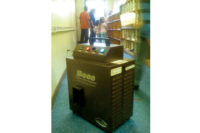New Device Uses Hydroxyl Radicals, Plasma Jets for Water Purification

Disaster restoration isn't the only space finding use for hydroxyl radicals.
Researchers at the University of Alabama in Huntsville have been studying a new type of plasma generator for water purification. The new generator pulses voltage signals to ionize gas at atmospheric pressure and produce many useful byproducts, including hydroxyl radicals, which cause a cascade of reactions that lead to purer water samples.
"We're finding ways to speed up the purification process," said Ryan Gott, a doctoral candidate in aerospace engineering at UAH who presented the research at the American Physical Society 71st Annual Gaseous Electronics Conference and the 60th Annual meeting of the APS Division of Plasma Physics, which took place Nov. 5-9 at the Oregon Convention Center in Portland.
"In theory, if this technology can be developed in a real-world, practical system, it would be able to purify water at lower costs than current methods can," Gott said.
While the term "plasma" conjures images of superhot solar jets traveling through space, most plasma-based water purification approaches work through plasma's ability to generate reactive free radicals, rendering many compounds in the water inert. The plasma and ensuing chemical reactions release energy and chemical species that can kill even tough microcystin bacteria, one culprit in algal blooms that lurk in our water supply.
"The pulses are so fast that it doesn't change the temperature of the water," Gott said. "You can touch our plasma jet with your hand."
Looking for a reprint of this article?
From high-res PDFs to custom plaques, order your copy today!








